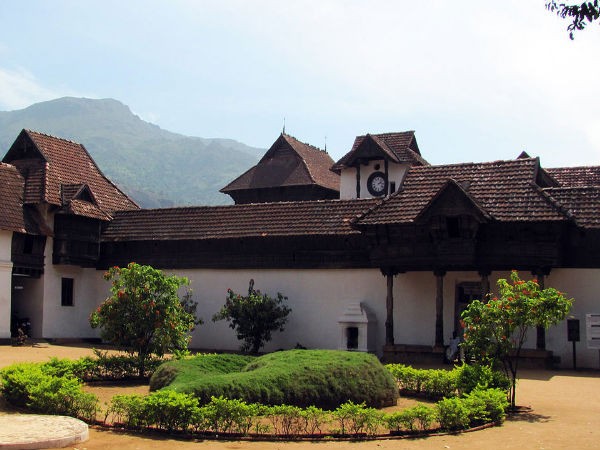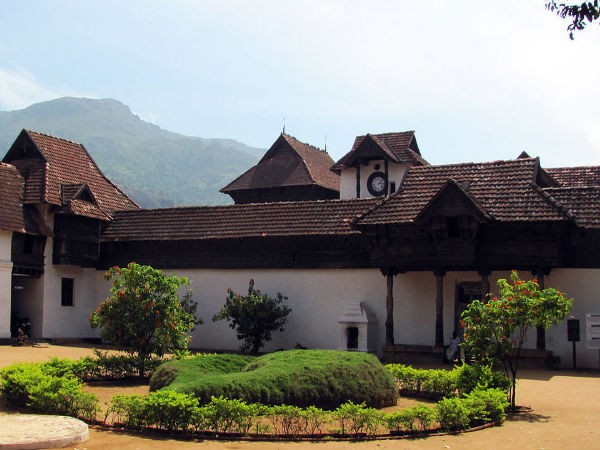
One of the royal palaces of the kingdom of Travancore, The Padmanabhapuram Palace is a charming gem of Kerala’s vast heritage. Occupied as the seat of governance from the 16th to the late 18th Century, the royal palace is one of the most popular historical attractions of Kerala. Though geographically a part of the state of Tamil Nadu in the Kanyakumari district, the royal building is maintained and protected by the Government of Kerala, Department of Archaeology.

Located 50 km from Kerala’s state capital-Thiruvananthapuram, in Thuckalay, at the foothills of Veli Hills amid Western Ghats, the royal palace of Padmanabhapuram captures the beauty, charm and amazing architecture of its time. In its erstwhile peak of glory, while it was the capital of the Travancore kingdom, the place was named after the presiding deity. The name- padma means lotus, nabha-navel, puram- town, comes from the Hindu mythology of the lotus that comes out of the navel of Lord Vishnu.
History of Padmanabhapuram Palace
The 4-centuries old Padmanabhapuram Palace is till date the largest wooden place in Asia. It was established by the ruler named Iravi Varma Kulasekhara Perumal of the royal family of Travancore in 1601 AD. Till the late 18th century, when the capital of Travancore was shifted to Thiruvananthapuram, the palace was the hub of activity.
Now, the palace is on the tentative list of UNESCO World Heritage sites for its incredible architecture, planning, artistic creations and more.
Features Padmanabhapuram Palace
The historic gem of Kerala, the royal relic of the Travancore family, Padmanabhapuram Palace is a sprawling wooden palace complex is secured by stone fortifications with a moat running all around the fort walls. Built from locally available materials and techniques, the impressive buildings have employed burnt brick, lime mortar, various herbs and secret ingredients to create the inimitable masterpiece.
Check out the must visit places in Padmanabhapuram Palace
- Council Chamber- Mantrasala
Named as one of the most beautiful parts of the entire palace complex, King’s Council chamber also known as mantrasala is a must-visit attraction. The remarkable feature of the chamber is the shimmering luster of the building which is unique as its beauty. Its finesse comes from the combination of egg white, lime, coconut, charcoal, river sand, jaggery, etc. The beautiful intricate lattice work spellbinds with its charm, while the colored mica of the windows keeps the room naturally cool.
- Queen Mother’s Palace
One of the oldest buildings in the royal palace complex, the Queen Mother’s Palace is built in traditional Kerala style architecture. Dating around the mid-16th century, the building comprise of an inner courtyard supported by four pillars, called ‘nalukettu’. On the south-west corner is a smaller room- the chamber of solitude or ‘ekantha mandapam’. The room is adorned in beautiful and intricate wood carvings, of which the most fascinating piece is the pillar of single jackfruit wood.
- Performance Hall- Nataksala
A relatively new addition in the palace, built in the 19th century, the performance hall was the vision of Maharaja Swathi Thirunal of Travancore who ruled from 1829 to 1846. Known as a great connoisseur of arts, especially music and dance, the King himself composed music and has left a rich legacy to classical carnatic music.
Walk amid the solid granite pillars and gleaming black floor. Take a look at the wooden enclosure, with peepholes, where the women of the royal household watch the performances.
- Central mansion
In the very heart of the Padmanabhapuram Palace complex lies the four-storeyed central mansion. The royal treasury of the kingdom occupied the ground floor, while the first and second floor was used by the King and the topmost floor in the mansion stands dedicated to Sree Padmanabhaswamy, the revered deity of the royal family.
In the royal bedroom of the King, take a look at the ornamental bedstead, a gift from the Dutch merchants, made of 64 types of herbal and medicinal woods. The marvelous study and resting room in the second floor was used by the King in his days of fasting. The worship chamber on the top floor is most impressive as it is decorated in brilliant 18th century murals, illustrating stories from Puranas and other mythological texts. The reverence for the chamber is clear from the fact that the king ruled the state as a servant of the Lord.
The most fascinating feature is that most of the rooms in the mansion and in other parts of the palace complex have built-in recesses in walls for storing weapons like swords and daggers.
- Southern Palace- Padmanabhapuram Palace Archeological Museum
The Southern Palace in the complex is now an archeological museum constructed by the department of archeology. Showcasing a collection of archeological findings from the southern part of Kerala, the museum has a number of treasures. Marvel at the exhibits from the Indus Valley excavation, ancient coins, wooden sculptures, stone structures, ancient weapons, copies of mural paintings, etc.
A daunting exhibit at the museum is the iron cage used by the Travancore state to lock up criminals, which were hung on trees, leading to slow death due to starvation and vultures.
Also Read: 7 Most Famous Festivals in Kerala That You Must Join and Enjoy
Other features of the Padmanabhapuram Palace Complex
- A 300-year old clock tower, which still keeps time.
- The big ceremonial hall hosting feats and auspicious events with a capacity to accommodate around 1000 guests.
- A secret passage for emergency, now blocked, through which the royal family and associates could escape to Charottu kottaram, another royal palace of the Travancore.
- A room full of old Chinese jars, which were gifted by Chinese merchants.
- Weapons used in warfare, including swords and daggers.
- Brass lamps, wood and stone sculpture, furniture, large mirrors made of polished metal, etc.
- A gallery of paintings, portraying incidents from the history of Travancore.
How to reach Padmanabhapuram Palace
The nearest railway station is Nagercoil in Kanyakumari District, 20 km away. While, the closest airport is in Thiruvananthapuram, almost 50 km away.
Also Read: 10 Famous Historical Monuments of Kerala
